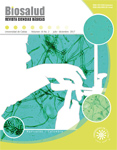Authors
Abstract
To analyze and compare the effect of temperature on the average velocity of the linear phase and the exponential phase stages produced by periodic stimulation with simple twitching or with tetanus in the toad sartorius. Methods: an in vitro experimental study with a sample of 46 toad sartorius muscles randomly selected. At the temperatures studied, peak tension produced with two stimulus patterns (twitching and tetanus) were measured until reaching the corresponding muscle fatigue in each case. The tension velocity drop in the linear phase and the exponential phase for each type of fatigue were calculated, and the regression slopes obtained with the Arrhenius equation were compared. Results: The temperatures used (1 to 12°C) significantly affected the velocity of fatigue in the stages of linear and exponential phases of both types of fatigue (p 0.05). Conclusions: The temperature significantly affected average development velocity of fatigue in the different phases of the two types of fatigue, but when comparing slopes of most regressions corresponding to Arrhenius there were no significant differences, suggesting that the mechanisms underlying the different stages of fatigue have equal sensitivity to temperature.
References
2. Lännergren J, Westerblad H, Bruton JD. Slow recovery of force in single skeletal muscle fibres. Acta Physiol Scand. 1996 Mar; 156(3):193–202.
3. Aljure EF, Borrero LM. The evolution of fatigue associated with isometric contraction in toad sartorius. J Physiol. 1968 Feb; 194(2):289–303.
4. Giraldo JC, Borrero LM. Estudio de la recuperación de la capacidad para generar tensión en músculo sartorio aislado de sapo Bufo marinus, después de fatigas por sacudidas simples y por tétanos. Rev Médica Risaralda [Internet]. 2012 Dec 21 [cited 2013 Oct 29]; 8(1). Disponible en: http://revistas.utp.edu.co/index.php/revistamedica/article/view/8153
5. Herrera E, Borrero LM. Caída lineal de tensión (CLT) y sus relaciones en fatigas por sacudida simples (FSS) y por tétanos (FTT) periódicos. XXX Congreso Nal. ACCB; Bogotá 1995;112-113.
6. Gonzalez-Serratos H, Borrero LM, Franzini–Armstrong AC. Possible role of mitochondria in the development of fatigue. Journ Gen Physiol. 1973; 62(1).
7. Inamura N, Fujisige A, Miyake S, Ono A, Tsuchiya T. The Effects of Temperature on the Mechanical Performance in Fatigued Single Muscle Fibers of the Frog Induced by Twitch and Tetanus. Jpn J Physiol. 2000; 50(1):49–57.
8. Clark WM. Topics in physical chemistry. Williams & Wilkins Co.; 1948.
9. Jones JH. Comparative Physiology of Fatigue. Med Sci Sports Exerc. 2016; 48(11):2257-2269.
10. Haeussler EF, Paul RS. Matemáticas para administración y economía. Pearson Educación; 2003.
11. Debold EP, Dave H, Fitts RH. Fiber type and temperature dependence of inorganic phosphate implications: for fatigue. Am J Physiol - Cell Physiol. 2004 Sep 1; 287(3):C673–C681.
12. Hohenauer E, Cescon C, Deliens T, Clarys P, Clijsen R. The effect of local skin cooling before a sustained, submaximal isometric contraction on fatigue and isometric quadriceps femoris performance: A randomized controlled trial. J Therm Biol. 2017 Apr; 65:88-94. doi: 10.1016/j.jtherbio.2017.02.017.Epub 2017 Feb 27.
13. Eusebi F, Miledi R, Takahashi T. Aequorin-calcium transients in frog twitch muscle fibres. J Physiol. 1983 Jul 1; 340(1):91–106.
14. Decostre V, Bianco P, Lombardi V, Piazzesi G. Effect of temperature on the working stroke of muscle myosin. Proc Natl Acad Sci U S A. 2005 Sep 27; 102(39):13927–32.
15. Williams JH, Ward CW, Spangenburg EE, Nelson RM. Functional aspects of skeletal muscle contractile apparatus and sarcoplasmic reticulum after fatigue. J Appl Physiol. 1998 Aug 1; 85
(2):619–26.
16. Lännergren J, Westerblad H. The effect of temperature and stimulation scheme on fatigue and recovery in Xenopus muscle fibres. Acta Physiol Scand. 1988; 133(1):73–82.
17. Bressler BH. Isometric contractile properties and instantaneous stiffness of amphibian skeletal muscle in the temperature range from 0 to 20 degrees C. Can J Physiol Pharmacol. 1981 Jun; 59(6):548–54.
18. Ranatunga KW, Wylie SR. Temperature-dependent transitions in isometric contractions of rat muscle. J Physiol. 1983 Jun; 339:87–95.
19. Hill DK. Resting tension and the form of the twitch of rat skeletal muscle at low temperature. J Physiol. 1972 Feb 1; 221(1):161–71.
20 Nocella M, Cecchi G, Bagni MA, Colombini B. Effect of Temperature on Crossbridge Force Changes during Fatigue and Recovery in Intact Mouse Muscle Fibers. PLOS ONE 2013, 8(10): e78918. doi:10.1371/journal.pone.0078918
21. Nocella M, Cecchi G, Colombini B. Phosphate increase during fatigue affects crossbridge kinetics in intact mouse muscle at physiological temperature.J Physiol. 2017 Jul 1; 595(13):4317-4328.

 pdf (Español (España))
pdf (Español (España))
 FLIP
FLIP


















